

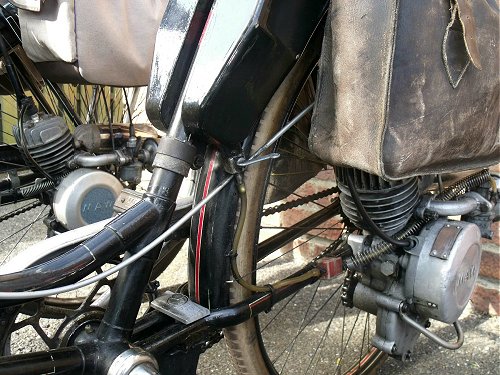
We had some visitors from The Netherlands at the Coprolite Run. Among the machines they rode were a pair of MAW cyclemotors. In Germany, these engines have gained the nickname of the "Magdeburger Hackenwärmer" - Magdeburger from its city of origin, Hackenwärmer because of its position where it warms your heel.
The MAW was made by Meßgeräte und Armaturenkombinat Werke at the Karl Marx works in Magdeburg. The 39.8mm × 40mm engine is of unusual construction with the integrated cylinder and crankcase made from two alloy castings - the entire unit splits along the centre line. A steel cylinder sleeve fits between the two cylinder halves.
The engine fits alongside the cycle’s rear wheel, like a VAP or a Bantamotor, and has a final drive by chain.
The sprocket clamps to the flange of the hub, while the engine itself clamps to the cycle’s chain stay. To keep the engine upright there is an additional stay to the cylinder head.
The engine is rated at 1hp and the pair on the Coprolite Run showed a reasonable turn of speed, easily keeping pace with the main pack of riders along the route.
First published in The MAC in December 2012
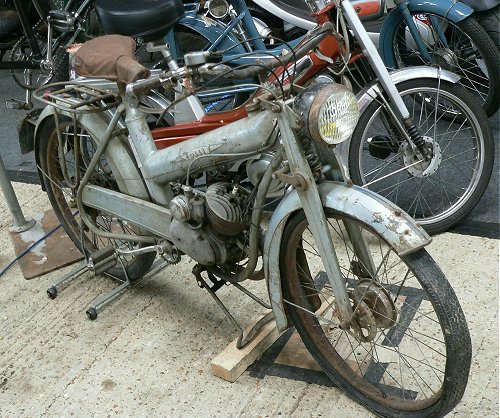
This Follis was one of several French vélomoteurs on our club stand at Copdock Show.
The French equivalent of the autocycle was the BMA (bicyclette à moteur auxilaire); a legal category that limited the bikes to 100cc and 30km/h. This category of machine was introduced between the two World Wars and became very popular.
During World War II, the legal definitions changed. The bottom end of the scale was now the under-50cc cyclomoteur, equivalent to our moped. The BMA went and, in its place was the vélomoteur: a motor cycle of 125cc or less.
This left the under-100cc machine with pedals somewhat cut adrift from the legal definitions - just like the autocycle in the UK. Nevertheless, like the autocycle, there was still a demand - maybe from people who wanted something a bit better than a moped but didn’t think of themselves as motorcyclists.
Founded in 1903, Follis made bicycles and motor cycles near Lyon in France.
The distinctive large-tube frame, which acts as the petrol tank, was introduced in 1950.
This design was produced both as a 50cc cyclomoteur with VLT or Marquet engines, or like this one, as a 100cc vélomoteur with a Sachs engine.
First published in The MAC in December 2012
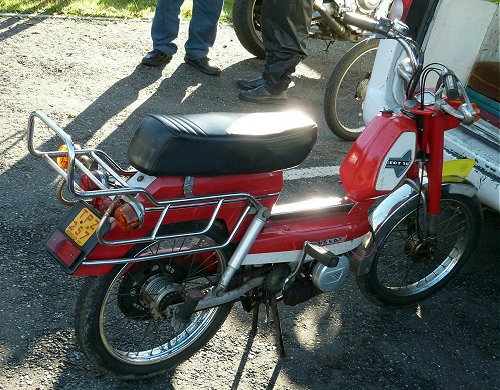
Back in November, this Peugeot 104 appeared at Coddenham Vilage Hall for our Kneel’s Wheels event, but it wasn’t there to take part in the run—it was just a convenient time and place to inspect it before issueing a dating certificate. As you can see from the rear number plate, it was a recent import from The Netherlands and had not yet been registered in the UK.
The 104 was the top of the range of Peugeot’s ‘step-through’ mopeds and would, therefore, be a direct competitor to Motobécane’s Mobylette AV89. Early versions were called the BB104 and had a leading-link fork and copious bodywork. The “BB” prefix was dropped after a while.
This one is the second version of the 104 with a more modern styling. This model was introduced in 1970 and had its ‘Service des Mines’ approval on July 15 that year.
There were several variations available: single-speed and variator models, single seat and dual seat. As with many French machines, suffixes to the model number indicate the features, making this a 104VBi … V for variator, Bi for selle biplace (dual seat).
First published in The MAC in March 2013
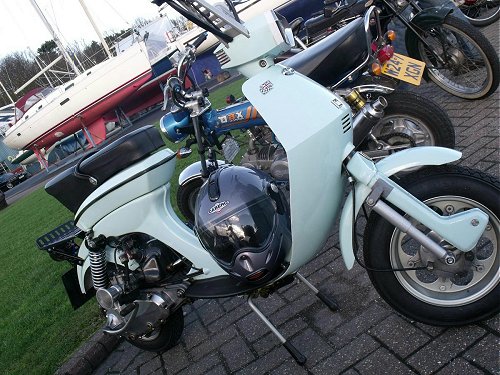
Pictured outside the Shipwreck Bar at Shotley, the half-way stop on the Mince Pie Run on 30 December, this is a Lambretta … something.
When Lambretta introduced its ‘space-age’ range of scooterettes to the UK there were, according to the brochure, three models in the range: the 49cc Luna and 74cc Vega and Cometa. The Cometa had automatic lubrication, while the Vega used pre-mix.
However, if we turn to Glass’s Guide, there were only two models in the range, introduced in November 1968. These were the Luna 75S Vega and the Luna 75SL Cometa—no mention of the 50cc model.
And, just to add further confusion, the badge on the front says it’s a “Lui”.
Whatever it was called, the styling (by Bertone) was very futuristic and most people, seeing one today, wouldn’t guess that it’s well over 40 years old.
The range did not sell in large numbers and production stopped in 1969—though existing stocks were still being listed in the UK in 1971.
First published in The MAC in March 2013
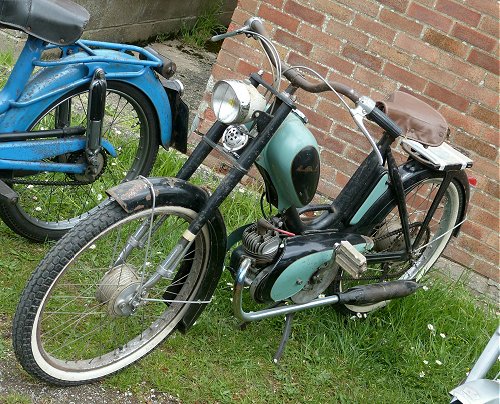
On show at the East Anglian Run, though it didn’t go on the run, was this Automoto CCV. Automoto was one of several manufacturers that were based around St Étienne and made its first motorised machine, a tricycle similar to De Dion-Bouton machines, at the end ot the 19th Century.
Automoto was taken over by Peugeot in April 1930. Despite the take-over, Automoto retained a good deal of autonomy. The first Automoto moped appeared in 1950. More models were added over the next few years, building up a complete range of machines. None of these was derived from Peugeot’s designs; they were mostly Automoto’s own with a couple coming from RSI-Motobloc. It was not until 1956 when re-badged Peugeots began to enter the Automoto range with Le Furet, an Automoto-badged Peugeot Bima. By 1960, the entire Automoto range consisted of ‘badge-engineered’ Peugeots.
The Peugeot-derived models all had Peugeot engines, but this one has a VAP engine, so we can conclude that it is one of Automoto's own designs. Furthermore, since the engine is a VAP 57, we know it dates from the period when Automoto’s own designs were being replaced by Peugeot’s.
First published in The MAC in June 2013
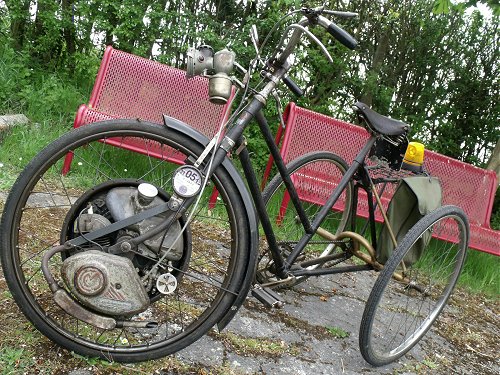
We stay at the East Anglian Run for our second ‘Spotted’ and this one is an even more unusual vehicle. Not so long ago, getting a machine like this on the road would have been a bureaucratic nightmare.
What taxation class is it? Well, nowadays, that’s easily answered: ‘Historic Vehicle’, no longer any need to count the wheels, measure how far apart they are or decide what counts as a ‘common axle’.
Next, the MoT. Like most cyclemotors, it should pass the MoT easily: there’s not that much there to be tested. But, before it can be tested, which MoT class is it in? Now that pre-1960 vehicles are exempt from MoT, that’s another problem that doesn’t have to be solved any more.
The machine is a Cyclemaster powering a CWS bicycle fitted with a Holdsworth tricycle conversion. Fitting a Cyclemaster as a front wheel just needs the forks setting to the width of its hub and the addition of a torque reaction arm (which can be clearly seen in the picture). What’s less obvious in the photo is that this one also has a third brake lever, ingeniously arranged to operate the Cyclemaster’s coaster brake.
Will the relaxation of MoTs see other unusual vehicles, ones that don’t fit easily into standard categories, on the road? A Smith Flyer for example?
First published in The MAC in June 2013
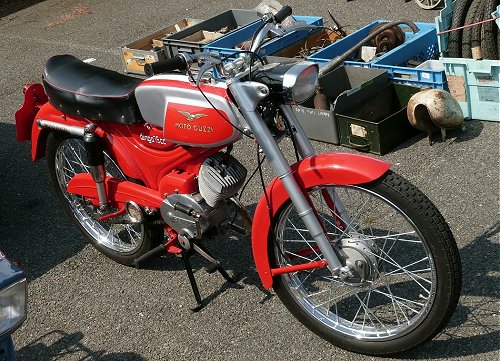
Although it says ‘Moto Guzzi’ on the tank, this is not an Italian machine: it was built under licence in Spain by Motor Hispania.
Five years ago this Moto Guzzi Dingo was featured in an article in Iceni CAM Magazine. Since then, it’s changed a bit: it’s looking a good deal smarter—and it goes better too. The transfers on the side say ‘Dingo 75cc’ where they used to say ‘Dingo 49cc’ but, in that respect, the transfer is the only thing that’s changed. It’s always had the bigger engine. Most of its improved performance has come from a carburetter change; the engine was struggling to breathe through a tiny 8mm carburetter when it was road tested five years ago; now a larger instrument allows the engine to show its potential.
Why it was originally branded with the smaller capacity is a little mystery that’s not been solved.
But its most significant change is the UK registration plate and the tax disc—indicative of the fact that it’s up and running and being used, instead of mouldering in a shed.
First published in The MAC in September 2013
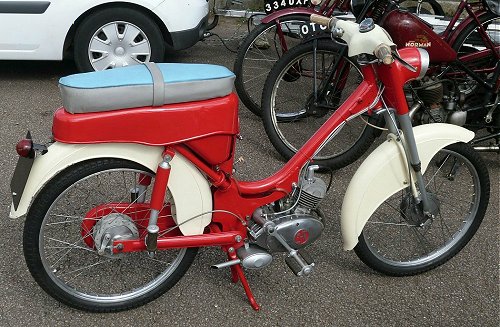
Now we move from Spain to Belgium.
This bike did not take part in the Periwinkle Run; it was there as it was a convenient time and place to get all the details for its dating certificate. So, although not on the road yet, we hope to be seeing it in action before very long.
It’s an FN Princess. FN was founded in 1889 as an arms company (Fabrique Nationale d’Armes de Guerre) and, like our own BSA and several other gun makers, diversified into other areas, including motor cycles.
In the motor cycle world, FN is probably best known for its shaft-drive in-line fours, a layout it introduced in 1905.
Fifty years after the first ‘four’, in 1955, the first FN mopeds were introduced. These were actually made by Royal Nord but, for 1959, FN introduced its own in-house range of four models: the Utility, Fabrina, Princess, and Rocket. The Rocket was the sports model while the other three were utility types finished in increasing levels of trim—but all four were based on the same frame and engine.
The Fabrina and Princess were also available as ‘Scooterized’ models with full legshields.
First published in The MAC in September 2013